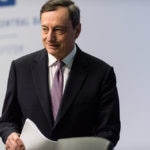How low interest rates impact bank profitability
Mario Draghi reiterated this week that the ECB could tentatively delay the planned rate hike until next year. At a conference in Frankfurt, Draghi responded to banks’ concerns by saying negative rates could impact bank profitability, although it “is not an inevitable consequence.” Given these statements, we asked Olga Gouveia, Lead Economist for Financial Systems at BBVA Research, what is the impact of the decision to keep negative interest rates. In her opinion, it is reasonable the precautionary tone of the ECB, provided that there is a planned hike on the horizon.

A hike in interest rates has been expected this year; however, the anticipated increase has been delayed until the end of 2019 or even 2020. In fact, this delay could grow even longer, according to a statement made by Mario Draghi, President of the European Central Bank, at the conference “The ECB and its Watchers XX.”
Draghi is no stranger to the potential impact of this decision on the financial sector. In fact, he directly alluded to the issue, saying that the “ECB will continue monitoring how banks can maintain healthy earning conditions while net interest margins are compressed.” Furthermore, he believes “if necessary, we need to reflect on possible measures that can preserve the favourable implications of negative rates for the economy, while mitigating the side effects, if any. That said, low bank profitability is not an inevitable consequence of negative rates.”
Olga Gouveia explains that “what has a greater impact on banks, in addition to interest rate levels, is the slope of the curve, which continues to be positive. Therefore, the expectation of higher interest rates in the future is positive for banks.” On the other hand, a unidirectional link between the rise in interest rates and increased profitability should not be established. There are many interrelated factors with positive and negative effects on profitability.
Nonetheless, continuing to delay the rate hike has a “lag” impact that, according to Gouveia, on one hand shows that Spanish banks are well positioned for an increase, and on the other, defers the benefit.
“We also see that the ECB, when faced with deterioration in the economic climate, exercises increased caution and adjusts monetary policy instruments and liquidity in order to minimize risk. We should interpret this as something positive in the sense that it mitigates the downturn. It avoids a contraction that could have a much more negative impact on the banking business,” concludes the expert.
Furthermore, Gouveia explains that the delay in the rate hike means that banks’ financing costs continue to be very tight – meaning they continue to be low – and families and companies will continue to benefit from low finance costs, with a subsequent positive impact on their payment capacity default rates, which is always positive.
How will banks respond?
When asked what measures the banks can take to alleviate the delay to the rate hike, Gouveia clarifies that, despite the difficult European economic environment, the situation has been established and, therefore, it is manageable. “The current backdrop hasn't changed, so banks will continue doing what they have been doing these past quarters and years. Low interest rates are nothing new,” she says.
It is undeniable that the banking sector's endurance is being put to the test, but as the BBVA expert affirms, “this correction has its positive aspects. Raising interest rates in a context of greater uncertainty and one in which the economy has still not shown entirely positive signs, could be more difficult for banks in the long term.”
Gouveia also points out that “banks have made a considerable effort at rationalization.” Since the crisis in 2008, banks have cut costs with the aim to better manage economic complexities.